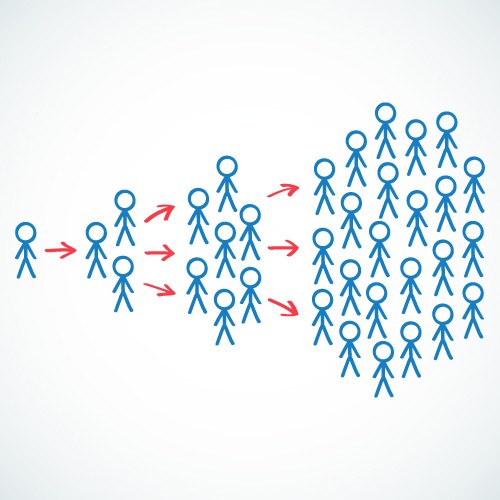Is viral marketing a reliable growth mechanism?

When the term ‘viral’ comes into conversation, the first thing that springs to mind may be videos of cats performing various un-catly acts, divergence of opinion on the colour of a blue/black dress or addictive video games featuring explosive birds. However, with the onset of peer-to-peer media and the mass interconnectivity of the internet age, the phenomenon of creating a chain reaction of social interaction is one that shouldn’t be ignored from a marketing perspective.
Marketers who will survive viral marketing
Indeed, with the growing saturation of formerly abundantly cheap PPC traffic sources such as Facebook, there are only two types of marketers set to survive as competition for newsfeed realestate rises.
- Those with zero marginal cost products or high leveraged marketing spend.
- Those who understand and can manipulate the natures of virality.
Now, many marketers or agencies will tell you that “you can’t make something go viral, it does or it doesn’t”, and to some extent that’s true. It’s all but impossible to predict what content or message will strike a chord in the collective consciousness of enough people to invoke mass sharing, however there are various clues that viral ‘things’, whether they be brands, campaigns or products, leave behind that are repeatable.
What is viral marketing?
First of all it’s important to explore the nature of the term ‘viral’ and create meaning for it within the context in which we operate. The dictionary definition of ‘viral’ as related to internet content is:
viral
/ˈvʌɪr(ə)l/
noun
“an image, video, piece of information, etc. that is circulated rapidly and widely on the Internet.”
The viral marketing coefficient
For something to become viral, it must be shared to on average more than one person by every one person it is shared to creating a positive ‘viral coefficient’. Viral Coefficient is a metric used to measure how fast something spreads. A coefficient of 1.0 for example represents one new share for every one share. A coefficient of 2.0 would represent two new shares for every one share.
Anything higher than 1.0 means the idea will continue to spread exponentially. The higher the coefficient, the faster and farther the content will spread. The progression of a viral coefficient over time regularly reflects a bell curve, as the content initially drives traction, achieves terminal velocity then gradually saturates the network in which it is being shared.
Targeting a niche market
The next thing to bear in mind is within what network, which niche community or which group of people we endeavour to achieve viral spread. Referring back briefly to the broadly held notion that it’s “impossible to make something go viral”, achieving virality on a global scale to all people of all interests and demographics would lean toward the less realistic end of the goal scale. Whereas, attempting to achieve virality within a tighter niche, say mechanical engineers or fans of Game of Thrones would be a lot more realistic, for three reasons:
- The target audience is smaller and likely better connected by networks relating to that niche, whether it be groups, pages or forums.
- The content can be tailored to be more specific and therefore have a higher chance of resonance.
- People are more likely to share something that reminds them of a specific friend or someone who shares a specific interest rather than something that applies to most.
As a business or marketer, it is at this point worth considering what peripheral interests your audience shares. Whether it be inside jokes about the nature of their industry or useful information that may help them transcend their current position or level of affinity within the niche.
3 traits that encourage content sharing
With this refreshed perspective of the term ‘viral’ we can start to address the actual mechanics of virality and how to use it as a genuinely valuable marketing mechanism that drives growth and sales. What are the traits in viral content that incentivise sharing? Here are just a few:
1. Emotion
It’s broadly accepted that people act based on emotion and rationalise later. However it’s important to assign a closer definition of emotion in the context of sharing, as certain emotions actually reduce the likelihood that people will pass information on. In order for people to take action we must invoke physiological arousal. Emotions that trigger such arousal include, but are not limited to humour, anger, anxiety, excitement and awe. Emotions that trigger physiological sedation such as happiness, contentment and sadness activate lethargy and reduce the likelihood people will take action and share.
2. Specificity
For content to achieve virality it must be easily and succinctly communicated. Simple ideas spread. Not to say that a complex product or idea cannot harness the power of virality, but an active effort to simplify down to a tangible and accessible idea is essential to achieve mass sharing. The more ideas or concepts added, the harder it becomes to define, and therefore the less likely it is to be understood, adopted and spread.
3. Social Currency
There’s an unconscious question people ask themselves before sharing a piece of content: “Will sharing this make me look good?”. There can be a number of reasons something might reflect well on the sharer. First, it’s genuinely useful to the person they are sharing it to. Second, they are ahead of the curve by knowing about the content and will be regarded ‘in the know’. Third, it represents their humour and they wish to take ownership of the joke. Overarchingly, it strengthens the social bond between themselves and the person or group of people on the receiving end of the share.
The real secret here is to insert your brand, product or message into an existing conversation and leverage the social currency that already exists in billions of relationships all over the internet.
In order to transform viral content into a monetisable asset it must be tied to a sales process. There are a number of ways to do so whether it be directly, by creating content which is inherently useful, sharable and also drives the audience to a direct response offer, or indirectly by leaving a breadcrumb by which viewers can follow up to reach our offering. This is enhance by directly tracking visitors and engagers then retargeting them as a warm audience with advertising, the purpose of the viral content being to inform and bridge a relationship to the sponsoring party. This sort of tracking is achieved incredibly easily by building retargeting audiences of people who have watched a significant portion of the content.
It is important to note that achieving a viral coefficient of more than 1.0 does not necessarily mean endless, exponential growth. There are a number of factors that must be considered centred around the nature of networks, saturation and critical nodes.
When viral marketing fails
A critical node is a single point of failure in a network. In terms of the spread of viral content critical nodes are individuals or small groups who form a bottleneck between larger clusters of the network. This might be one individual who happened not to be online at the time the content was shared, or whose feed was oversaturated by other content at the time of sharing. For whatever reason, if a critical node fails in a network there is no way for the content to be shared beyond that point and regardless of how good the content is, it will stop dead at that point.
Another problem facing viral media for monetisation purposes is the nature by which social network algorithms disseminate content. Once engagement on the content starts to slow, the algorithms will make no further effort to spread the content organically as it is quickly classified as ‘old news’ and becoming less relevant to the platform’s audience.
A solution that provides some added exposure and opens up content to a new audience pool is simply re-posting the same content repeatedly over time, thus capturing new people when they are online. However when posting on social platforms like Facebook this eliminates the social proof of likes, shares and comments which play an important role in driving others to engage.
If the content has been attached to a sales process putting ad spend behind it means it will be run regularly, will reach new audiences, and the audience it reaches will be defined by us. This immediately reclassifies the content as a monetisable and most importantly scalable marketing asset.
Let's talk algorithms in viral marketing
It is a more scalable marketing strategy to have amonetisable piece of content with a low viral coefficient of 1.2 and run that content consistently as paid, targeted advertising than a piece with a high viral coefficient of 2.5 that sacrifices its relevance to the sponsoring party in favour of organic shares and will eventually fall prey to the undiscerning nature of organic platform algorithms, relegated forever to room 101.
Within this concept is the true secret of successful social media advertising and how virality can be effectively and profitably leveraged. The more interaction and engagement a post receives, the more relevant it is deemed by the platform’s algorithm and therefore, in a regular, bid-objective campaign our cost to reach exponentially more users will be dramatically lower. Algorithms work much the same with paid promotion as organic content on social media, therefore more engaging content is rewarded and spread further at a lower cost as more people react and engage.
Advertisers with content that does not drive this sort of engagement from users will struggle, their only option reduced to dramatically inflated bidding. Atop of that, they must reach far larger audiences to drive action from the smaller ratio of people who take action on their less engaging content. These two factors combined make for an uphill struggle which will only get harder as platforms become more saturated and PPC costs increase.
In closing...
Content does not need to be absurd, childish or completely detached from our business topic to leverage the power of virality at one scale or another. Virality relies on harnessing the niche interests and shared emotions in existing relationships and using our message to strengthen the social bonds of our customers and prospective
- Dave Rotheroe, Founder of Viral by Design.



